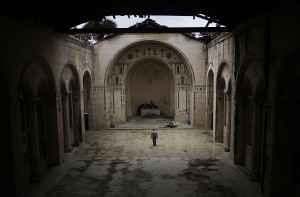HAVANA — Golden rays of tropical sunlight slant through the caved-in roof of Saint Thomas de Villanueva chapel, illuminating tiles graced by the faces of saints. Vandals shattered the stained-glass windows and scrawled their names on the thick walls during decades of frigid relations between the Roman Catholic Church and Cuba’s communist government.
But a new chain-link fence surrounds the building, protecting it for a future that once seemed unimaginable.
The church is planning to restore the building to its former glory, along with more a dozen more churches, parish houses and other buildings, as part of a quiet reconciliation between the Catholic Church and the Cuban government that has brought relations to a historic high point this Christmas. Authorities have also given permission for the construction of the first two new churches in more than five decades.
After years of bridge-building behind closed doors, the Cuba-Vatican rapprochement burst into the headlines last week when the U.S. government credited Pope Francis with helping facilitate the secret reconciliation talks between the U.S. and Cuba. Francis wrote the leaders of both countries to invite them to resolve their differences.

In this Dec. 1, 2014, a guard walks inside the chapel of the former University of Santo Thomas of Villanueva in Havana, Cuba. Since late 2009, President Raul Castro’s government has been quietly returning some church property that was confiscated in the years after the Cuban revolution, including this chapel. The rest of the university property was not returned. AP
Church officials and experts said the mediation and the renovation and construction of churches were essential parts of a fundamental shift in the dealings between the church and the communist state, which has been hostile toward religion for decades.
Developments “are heading in the same direction: a new chapter in the general and economic history of Cuba, and also church-state relations,” said Enrique Lopez Oliva, a religious historian at the University of Havana.
The church and the Cuban state were in a state of open hostility in the years immediately after the 1959 revolution that put Fidel Castro in power, a time when some anti-Castro militias used churches to store weapons.
Some priests were sent to labor camps. Churches were confiscated and used by the government as warehouses, bakeries, dining halls or schools.
Openly practicing Catholics were barred from holding public office and membership in the Communist Party. For the faithful, even winning admission to a university could be difficult, and the ubiquitous neighborhood watch committees kept an especially watchful eye on them.
But a thaw began in the 1990s as Cuba removed a constitutional clause declaring the country an officially atheist state. Pope John Paul II paid a momentous visit in 1998 and urged a new era of openness between Cuba and the world. After Benedict XVI visited in 2012, Cuba made Good Friday an official holiday.
Christmas decorations are increasingly visible in office buildings and homes each year. However, the church has made little headway in its hope for more access to state-controlled airwaves and permission to run religious schools.
Earlier this year the editors of a church magazine that has been one of the few independent publications in the country resigned, citing internal pressures from some who felt it was becoming too political.
According to a church member with direct knowledge of the matter, the handover of properties was mentioned during negotiations between Castro and Cardinal Jaime Ortega in July 2010, when the church mediated the release of a group of jailed dissidents.
The properties include two churches, a parochial house and other real estate that was being used as stores in Santiago, Cuba’s second-largest city; two plots of land and a chapel in the Bayamo-Manzanillo Diocesis; and the College of Jesuit Priests, a huge building that occupies more than a city block in Cienfuegos.
“It’s a very positive gesture by authorities, restoring to a certain extent what belongs to the church, and above all it creates an atmosphere of trust,” the Rev. Jose Felix Perez, adjunct secretary of the Cuban Catholic Bishops’ Conference, told The Associated Press.
“It’s all happening, it must be said, gradually.”
Ortega has publicly welcomed Castro’s economic and social reforms, which have enabled hundreds of thousands of Cubans to work for small private businesses and made it much easier for islanders to travel overseas. Those reforms have not extended to political change, and the Communist Party is still the only one allowed.
Despite the gradual opening, experts say the percentage of Cubans who are practicing Catholics remains well below that of most of the rest of Latin America. For many Cubans, Christmas is a day off work to hang out with family and neighbors, with no spiritual component whatsoever.
Joel Dopico, president of the Cuban Council of Churches, said other evangelical and Protestant churches are also receiving properties from the state. He had no precise figures, but said the returns were less than what the Catholic Church has gotten.
“I think very highly of this state policy to return some properties,” Dopico said. “It is part of the transformations that that are taking place in the country, where more and more the church will be able to carry out its work and support for the community.”
RELATED STORIES
Pope played crucial role in US-Cuba rapprochement
Pope heads to Cuba to shore up Catholic Church
Pope wraps Cuba visit with Mass, Fidel meeting

